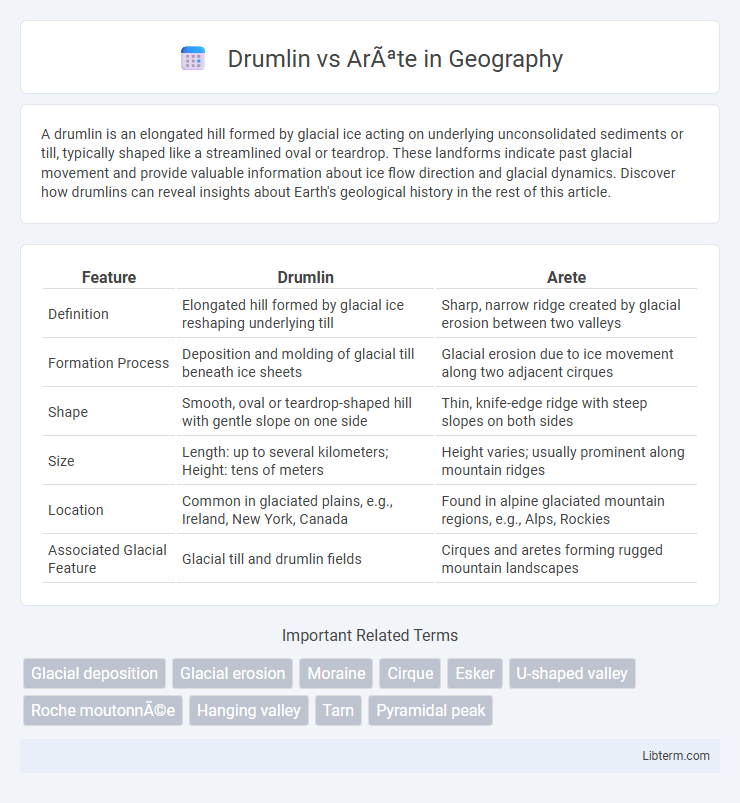A drumlin is an elongated hill formed by glacial ice acting on underlying unconsolidated sediments or till, typically shaped like a streamlined oval or teardrop. These landforms indicate past glacial movement and provide valuable information about ice flow direction and glacial dynamics. Discover how drumlins can reveal insights about Earth's geological history in the rest of this article.
Table of Comparison
| Feature | Drumlin | Arete |
|---|---|---|
| Definition | Elongated hill formed by glacial ice reshaping underlying till | Sharp, narrow ridge created by glacial erosion between two valleys |
| Formation Process | Deposition and molding of glacial till beneath ice sheets | Glacial erosion due to ice movement along two adjacent cirques |
| Shape | Smooth, oval or teardrop-shaped hill with gentle slope on one side | Thin, knife-edge ridge with steep slopes on both sides |
| Size | Length: up to several kilometers; Height: tens of meters | Height varies; usually prominent along mountain ridges |
| Location | Common in glaciated plains, e.g., Ireland, New York, Canada | Found in alpine glaciated mountain regions, e.g., Alps, Rockies |
| Associated Glacial Feature | Glacial till and drumlin fields | Cirques and aretes forming rugged mountain landscapes |
Introduction to Drumlin and Arête
Drumlins are streamlined, elongated hills composed of glacial till formed beneath moving ice sheets, indicating the direction of glacier movement. Aretes are sharp, narrow ridges carved by the erosion of two adjacent glaciers, typically found in alpine environments. Both landforms reveal distinct glacial processes: drumlins illustrate ice flow dynamics, while aretes demonstrate intense freeze-thaw weathering and glacial carving.
Definition of Drumlin
A drumlin is a streamlined, elongated hill formed by glacial ice acting on underlying unconsolidated till or ground moraine, typically shaped like an inverted spoon or half-buried egg. Unlike an arete, which is a sharp mountain ridge formed by the erosion from two adjacent glaciers, drumlins are depositional landforms created beneath glaciers. Drumlin fields indicate the direction of past glacial movement and consist primarily of glacial sediments.
Definition of Arête
An arete is a sharp, narrow ridge formed between two glacial valleys or cirques, created by the erosive action of parallel glaciers carving away the rock on either side. Unlike drumlins, which are smooth, elongated hills of glacial till shaped by glacial movement, aretes represent jagged, knife-edge topographical features that highlight intense glacial sculpting. These ridges are typically composed of resistant rock, serving as clear indicators of past glacial activity in mountainous regions.
Formation Process of Drumlins
Drumlins form from glacial processes where glaciers reshape underlying sediments composed of clay, silt, sand, and gravel while actively advancing. The movement of ice molds these elongated, streamlined hills typically aligned in the direction of glacier flow, indicating past ice movement patterns. In contrast, aretes develop through alpine glacial erosion, where two adjacent glaciers carve steep, narrow ridges from bedrock.
Formation Process of Arêtes
Aretes form through glacial erosion when two parallel glaciers carve out adjacent U-shaped valleys, sharpening the ridge between them into a narrow, knife-edge crest. Freeze-thaw weathering further accentuates the arete by breaking down rock along its edges, creating steep, jagged slopes. This contrasts with drumlins, which are streamlined hills formed by glacial till deposition and ice flow.
Key Geological Differences
Drumlins are elongated, smooth hills formed by glacial ice reshaping underlying till, characterized by their streamlined shape pointing in the direction of ice movement. Aretes are sharp, narrow ridges formed by the erosional action of glaciers on either side, often found in mountainous regions where two cirques erode a ridge from opposite sides. The key geological difference lies in drumlins being depositional landforms sculpted beneath moving ice, whereas aretes are erosional features created by glacier carving.
Typical Locations and Environments
Drumlins commonly form in glaciated valleys and lowland regions shaped by continental ice sheets, especially in areas like the upper Midwest of the United States and Ireland, where glacial sediments are abundant. Aretes develop in high alpine environments, typically found in mountain ranges such as the Rockies or the Alps, where glaciers erode steep ridges between adjacent cirque basins. These distinct settings reflect the contrast between depositional landforms created by glacier movement in broad plains and erosional features sculpted by ice in rugged mountainous terrain.
Visual Characteristics and Identification
Drumlins exhibit smooth, elongated, and teardrop-shaped profiles formed by glacial ice movement, typically oriented parallel to ice flow, with gentle slopes and asymmetrical shapes tapering downstream. Aretes are sharp, narrow ridges formed by glacial erosion between two cirques or valleys, characterized by steep, jagged edges and a knife-like appearance often composed of exposed bedrock. Identifying drumlins involves observing their streamlined, rounded forms lying in clusters, while aretes are recognized by their distinct, serrated crests rising sharply above surrounding terrain.
Importance in Glacial Landscapes
Drumlins are streamlined hills formed by glacial ice movement, providing crucial evidence of past glacier flow direction and dynamics, which aids in reconstructing ancient ice sheet behavior. Aretes, sharp ridges carved by glacial erosion between adjacent cirques, highlight the intensity of glacial sculpting and are key indicators of glacier retreat patterns. Both landforms play vital roles in understanding glacial geomorphology and the evolution of mountainous landscapes shaped by glaciation.
Drumlin vs Arête: Comparative Summary
Drumlins are smooth, elongated hills formed by glacial ice reshaping underlying sediments, typically found in clusters within glacial landscapes, whereas aretes are sharp, narrow ridges created by the erosive action of glaciers carving away mountain ridges. Drumlins indicate glacial movement direction with their tapered end pointing downstream, while aretes highlight ice erosion between two adjacent cirques or valleys. The contrasting landforms emphasize glacial deposition for drumlins and glacial erosion for aretes, reflecting distinct processes in glacial geomorphology.
Drumlin Infographic

 libterm.com
libterm.com